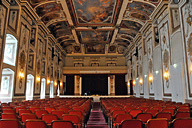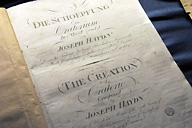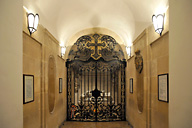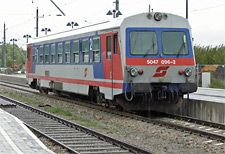Joseph Haydn (1732-1809) worked as a court musician for over 30 years at Schloss Esterházy in Eisenstadt. He started here as assistant music director in 1761, and was appointed Kapellmeister (in charge of all the music for the wealthy Esterházy family) in 1766. His isolation from other composers and the musical trends of the time "forced him to become original", he said. He moved to live in Vienna in 1795, following the death of his patron Prince Nikolaus Esterházy in 1790 and his highly successful visits to London. So Eisenstadt was an important destination for me on my Grand Tour – a day trip from Vienna... / more |
Schloss Esterházy
The Esterházy palace is large and very yellow. I headed quickly to the inner courtyard and bought a ticket for a guided tour, in German, with brief but very adequate English notes. The building came into the possession of the Esterházy family in 1649. All the rooms are richly and heavily decorated, and include a remarkable display of porcelain and silver. But of particular interest to me, before reaching the Haydnsaal, were the two music salons...
• Click for photos and more |
 |
Haydn-Haus
The Haydn-Haus museum in the centre of the old town, in a street now called Joseph-Haydn-Gasse, is where Haydn lived from 1766 until 1778. Only a few rooms, but surprisingly large. Paintings and drawings of course, and some furniture of the period, plus a piano from 1780, and an organ dating from 1797 which was originally in the Bergkirche...
• Click for photos and more |
 |
Bergkirche and Haydn Mausoleum
I walked west up the main road – away from the old town – to the Bergkirche, to visit the Haydnmausoleum. It was built by the Esterházys, at the base of the north tower of the church, in recognition of Haydn's long service as their Kapellmeister, although they didn't actually get around to building it until 1832, 23 years after his death...
• Click for photos and more |
 |
 I travelled the 50km from Vienna to Eisenstadt by rail (of course); a streamlined regional train, open right through, with a big space for bikes. A 3-minute wait and change of direction at Ebenfurth, then a change of train at the splendidly-named Wulkaprodersdorf station – with its low, narrow platforms and people wandering over the track – into an elderly single-coach train for the 8-minute journey to Eisenstadt across flat-ish, slightly rolling countryside; a few vines, orchards, corn. The return journey was interesting because it's not obvious which way the double-ended coach is going to go – in fact it starts off travelling backwards for a few hundred yards to pick up the kids from school at a tiny platform, then returns to Eisenstadt, where it waits for several more minutes while some of them get off and more people get on, before starting on the journey back to Wulkaprodersdorf. I travelled the 50km from Vienna to Eisenstadt by rail (of course); a streamlined regional train, open right through, with a big space for bikes. A 3-minute wait and change of direction at Ebenfurth, then a change of train at the splendidly-named Wulkaprodersdorf station – with its low, narrow platforms and people wandering over the track – into an elderly single-coach train for the 8-minute journey to Eisenstadt across flat-ish, slightly rolling countryside; a few vines, orchards, corn. The return journey was interesting because it's not obvious which way the double-ended coach is going to go – in fact it starts off travelling backwards for a few hundred yards to pick up the kids from school at a tiny platform, then returns to Eisenstadt, where it waits for several more minutes while some of them get off and more people get on, before starting on the journey back to Wulkaprodersdorf.
A 10-15 minute walk from the station to Schloss Esterházy, at the west end of the town; I bought a €9 joint ticket covering the 11:00 tour and the Haydn-Haus. Later, finding food took ages. Everything seemed to be shut, and much looks run down (at the west end of town anyway), not at all what I was expecting from the Eisenstadt website, which had given me the impression of an up-market place trading on Haydn and the conference business. I ended up at Cafe Schloss for a beer and Käsetoast – a cheese toasty – just that: no garnish, no tomato, no knife, no fork, no serviette. And the mild Austrian cheese doesn't cook too well either. But the people were nice. |
|
|